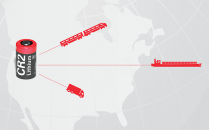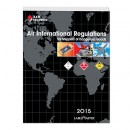Previously recorded on Wednesday, March 18, 2015 at 2:00 p.m. CST Shipping dangerous goods by air seems to have the most frustrated shipments. Sometimes the reason seems to be trivial. Join Jim Shimko, Labelmaster Services and Angel Collaku, Compliance and Enforcement Division Manager from the FAA, as they discuss some of the more common errors…
Canada Revises WHMIS to Incorporate GHS
Health Canada (more-or-less the Canadian government’s equivalent of the Occupational Safety and Health Administration (OSHA) in the United States) has officially published their adoption of the United Nations Globally Harmonized System for the Classification and Labeling of Hazardous Chemicals (GHS) into their Workplace Hazardous Materials Information System (WHMIS) (i.e. the approximate equivalent of the US…
PHMSA Announces Mandatory Compliance Date Extension to HM-224F for Non-Air Transport of Lithium Batteries
Announced via the website of the Department of Transportation, Pipeline and Hazardous Materials Safety Administration (DOT PHMSA): as a result of numerous stakeholder comments, PHMSA will respond to concerns regarding difficulty in achieving full compliance by the original date set forth in the timeline mandated by the August 6th, 2014 final rule. The agency announced…
Postal Service Revises Mailing Standards for Lithium Batteries
Keeping pace with U.S. DOT’s PHMSA (U.S. Department of Transportation, Pipeline and Hazardous Materials Safety Administration) the U.S. Postal Service announced changes to their respective hazardous materials standards affecting the safe transportation of lithium ion and lithium metal batteries. According to the Notice published in today’s Federal Register (January 26, 2015, Volume 80, No. 16,…
USDOT/PHMSA Releases Final Rule HM-215M, Harmonizing Requirements with UNMR, ICAO, IMDG Code Changes
In the January 8th 2015 edition of the US Federal Register, the United States Department of Transportation’s (USDOT) Pipeline & Hazardous Materials Safety Administration (PHMSA) published a final rule under Docket # PHMSA-2013-0260 (HM-215), RIN 2137-AF05 under which the agency sets forth specific changes to the US 49 CFR Hazardous Materials Regulations (HMR) to harmonize…
NTSB Issues Safety Alert Regarding Adjacent LED/Incandescent Signal Aspects on American Railroads
The United States National Transportation Safety Board (NTSB) has issued a Safety Alert to railroads operating in the United States which cautions them about potential confusion or other risks associated with the presence of both LED and incandescent bulb type signal aspects placed adjacent to one another at rail junctions. Railroads are in the process…
ICAO releases Corrigendum #1 for the 2015 – 2016 edition; addresses the carriage of Lithium Metal Batteries aboard passenger aircraft
On December 10th, 2014, the International Civil Aviation Organization (ICAO) issued an Electronic Bulletin (EB 2014/72) which announced the release of Corrigendum #1 (itself dated November 20th, 2014) to their 2015 – 2016 edition of the Technical Instructions for the Safe Handling of Dangerous Goods, commonly referred to in the industry as the ICAO TI. The…
The Changing Regulations Pertaining to the Transportation of Lithium Batteries
In August of 2014 the U.S. Department of Transportation (DOT) promulgated final rule HM-224F affecting the safe transport of lithium batteries[i]. DOT announced that the resultant effects from the revisions of HM-224F will “strengthen safety conditions for the shipment of lithium cells and batteries. These changes, some of which focus specifically on shipments by air,…
DG and the C-suite: What every executive needs to know
In the first Master Series video, Labelmaster President Alan Schoen makes the case that Dangerous Goods (DG) shipping should be a topic at the CEO level and needs to be a bigger business discussion than it currently is. Beyond simply avoiding fines, proper DG management can be a core competitive advantage.
‘Why do I need a new Air Regs book every year?’
I’m often asked: why do I need a new Air Regs book every year? Always an interesting question and the answer changes every year! For 2015 though, it’s really simple. This is an ICAO year, one in which there’s a new edition of the ICAO Technical Instructions which is worldwide legal requirements for transporting dangerous…



